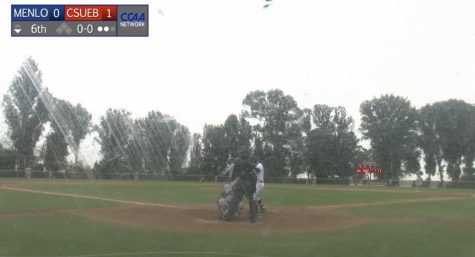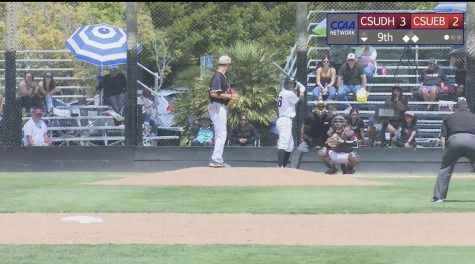Taken Off the Air: Sports Broadcast Opportunity Stripped Away from CSUEB Students
February 14, 2023


In September of 2021, the Department of Communication teamed up with the university’s Athletics Department to broadcast California State University, East Bay athletic events on the California Collegiate Athletics Association (CCAA) network, providing a unique opportunity for students to gain tangible skills and experience in the multimedia industry.
Despite the multitude of benefits the inter-department collaboration provided, the Athletics Department decided to cease the program in November of 2022, stripping opportunities from students and putting an end to CSUEB’s high-quality athletics coverage.
The program began as a modest agreement between Communications professor, Kevin Pina, and the university’s Athletics Director, Allison Kern to cover the 2021 National Collegiate Athletic Association’s Division 2 Western Regional Championship series. The deal was simple: the Department of Communication would provide job training and compensation for a crew of media production students under the mentorship and guidance of Pina, allowing them to gain valuable career experience. In return, the Athletics Department would be given access to higher-quality live streams of CSUEB sporting events.
The newfangled sports broadcast unit would soon expand its scope, airing softball and baseball games in the following 2022 spring season.
As the head of the broadcasting team, Pina used his wealth of experience to help budding broadcasters learn their way around a camera set and develop a portfolio to help with career advancements. “The sports broadcasting unit provides students with the opportunity to build skills towards their future careers while providing them with an on-campus employment opportunity,” Pina explained.
After the Athletics Department was restructured, however, the program began to fall apart. Student sports coverage continued until Fall 2022 when the broadcast unit was disbanded halfway through the soccer season.
The sudden disruption of a vital career pipeline left many dissatisfied, faculty and students alike. “I learned so much in the fall regarding broadcasting… I was looking forward to gaining experience announcing and producing baseball and basketball games in the spring [since] this is the career I am thinking about getting into, but now this experience won’t be possible,” expressed Michael Savin, a former member of the broadcasting team.
Citing financial strain, the Athletics Department reasoned that they “no longer had the bandwidth to manage paying student assistants” at the rate of $15-$20 per hour. Determined to keep the broadcast channel alive, the Department inquired interest to Communications alumni and Pina’s mentee Raphael Timmons to help transition the sports broadcast operations, thereby replacing the student team.
Timmons has declined their offer due to his current full-time commitment as the associate producer at the KQED, also unwilling to undermine the program as he attributes his post-graduation success to his work with the broadcasting team under Pina’s guidance.
“The East Bay Live Athletics Broadcast was my introduction to working in television/video. I can’t stress enough how much working on the production unit helped me develop the skills that eventually led to a job at KQED. Professor Pina poured so many hours into teaching us the craft. When you look at what that East Bay Live group has moved on to professionally, I think it really shows,” Raphael Timmons commented.
While Pina proposed to personally assume financial responsibility for the program to keep it afloat, the professor did not receive any feedback or response regarding his offer from the Athletics Department.
“All students who have worked with the sports broadcasting unit over the years have been able to add it as an actual job on their resumes, with several [students] going on to work in video production or related fields after graduation,” Pina stated, emphasizing the gravity of losing a treasured program.
While the prospects of earning a student salary may have been an enticing bonus for some, the program was an education cornerstone for many more. Such was the case with students in the “Multimedia Storytelling” course, for whom the broadcasts were a part of their curriculum. “To know that the end of our live-streaming sports was over so abruptly was disappointing and unreal,” shared Kieara Simmons, student and former broadcast team crewmember.
To Simmons and her fellow teammates, the curt cancelation of the program required former members to reshuffle their class schedules well beyond the course drop date: “[It was] disappointing to know that in the middle of the semester, we had to change the whole course of our class with no real answer or reason as to why.”
Lastly, Simmons believes that the Athletic Department’s decision was especially dismissive towards the labor of the broadcast crew, stating that, “it was unreal because it seemed like all the hard work we did as students were going unrecognized and unappreciated.”
The athletes are equally as devastated as the faculty and student staff, lamenting the loss of community around their sports. From passionate announcements from student casters to the capture of game-defining moments, the student-run broadcast network provided the athletes a chance to relive their biggest highlights and review their gameplay as an exercise of self-improvement. “The multi-camera setup was helpful to look back and watch my swing. It helped me see what I was doing right and wrong,” said baseball player Donovan Bailey.
The parents have also chimed in to praise the work of the previous student staff team and express their frustration at the decrease in broadcasting quality. “The single camera in the back with no announcer [makes it] hard for parents to watch,” a baseball parent commented, admitting that it is difficult to “watch [their] son play and know what is going on.”
In response, Kern provided the following statement on the matter: “Cal State East Bay Athletics is always looking for ways to create opportunities for students to be involved in our program – like working events, interning in our office, or helping with content creation, to name a few. While we want our students to be involved and gain experience through experiential learning, Athletics must balance that with our obligations to our student-athletes. When it comes to broadcasting our games, the approach and focus must be on creating a sustainable, predictable product for the campus community which also includes fans and the family and friends of student-athletes who reside across the country as well as our responsibilities to the CCAA.”
Based on the community feedback, however, cutting loose a troupe of student staff and replacing them with a single camera with no field supervision or announcer present, sacrifices broadcasting quality. Worse yet, the Athletic Department’s decision could be interpreted as contradictory in their pledge to “balance obligations to student-athletes,” much less to “create opportunities for students to be involved.”
With an abundance of video production equipment from the Communications Department now underutilized and a considerable amount of students otherwise eager to get career insight denied to do so, the motion to cancel the program seems less tenable.
For a $10 subscription service, our athletes, fans, and parents — all members of the CSUEB community that rely on our sports network as a source of entertainment, and learning, and as a way to stay in touch with the campus in lieu of busy schedules or daunting commutes — deserve better. Worst of all, by settling for low-quality production, we are sidelining our students and stunting career opportunities that they otherwise would not have access to. Experience is everything in today’s workforce, and undermining that goes against what college is supposed to be about — experimentation, career preparation, and networking.
















